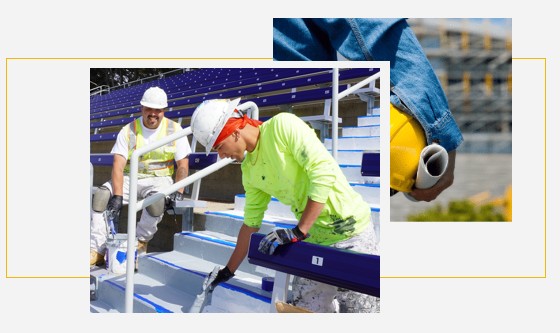Green construction is revolutionizing how we approach commercial building projects, offering significant benefits not only for the environment but also for employee health and productivity. As awareness of workplace sustainability grows, an increasing number of real estate developers and commercial property owners, are turning to green building practices to enhance their properties’ appeal and value. This is an important consideration for modern construction projects because it aligns with industry trends toward environmentally sound buildings and enhances employee wellness and productivity.
The Connection Between Green Buildings & Employee Health
Green buildings are at the forefront of enhancing employee health by providing work environments that prioritize wellness. These buildings are designed with a focus on maintaining high indoor air quality, reducing exposure to harmful pollutants, and ensuring access to natural light. By implementing green architecture and eco-friendly designs, employers can foster healthier workplaces that support employee wellness and reduce the likelihood of illness.
Green Design Features That Improve Indoor Air Quality
Indoor air quality is a critical factor affecting employee health and productivity. Green construction emphasizes the use of non-toxic materials, advanced ventilation systems, and air filtration technologies that significantly improve indoor air.
By minimizing volatile organic compounds (VOCs) and incorporating plants and green walls, these environmentally sound buildings ensure the air employees breathe is clean and rejuvenating.
How Energy-Efficient Offices Reduce Costs & Enhance Productivity
Energy-efficient offices are designed to optimize energy use through smart technologies and sustainable practices. Features like LED lighting, energy recovery ventilation systems, and effective insulation not only reduce energy consumption but also create comfortable workspaces that improve employee focus and output. These practices contribute to lower operational costs and a reduced carbon footprint, benefiting both businesses and the environment.
- LED lighting reduces energy use and lowers electricity bills while improving visibility and mood.
- Energy recovery ventilation (ERV) systems maintain indoor air quality without excessive heating or cooling costs.
- High-performance insulation and windows help stabilize indoor temperatures, minimizing HVAC use.
- Smart thermostats and building automation allow for optimized energy use based on occupancy and time of day.
- Natural lighting and daylight harvesting enhance employee alertness and reduce dependence on artificial lighting.
- Ergonomic, climate-controlled environments contribute to employee comfort and sustained productivity.
- Lower utility costs free up capital for business growth or investment in employee programs.
- Sustainable practices support environmental responsibility and can improve brand reputation.
- Reduced carbon footprint aligns with corporate sustainability goals and compliance regulations.
- Tax incentives and rebates may be available for energy-efficient upgrades, offering additional savings.
How Workplace Design Influences Employee Productivity
The configuration of floor space and the integration of green design elements can profoundly impact employee productivity. Open-plan layouts, collaborative zones, and quiet spaces cater to diverse work styles, allowing employees to thrive in balanced environments. Green designs prioritize natural lighting and acoustics, reducing stress levels and fostering a sense of well-being, which are key drivers of enhanced productivity.
The Role Of LEED Certification In Establishing Healthy Workplaces
Leadership in Energy and Environmental Design (LEED) certification sets the benchmark for high-performance green buildings. By achieving LEED certification, businesses underscore their commitment to sustainable practices and employee health.
The certification involves rigorous evaluation criteria focusing on energy use, water efficiency, air quality, and resource conservation, ensuring that certified buildings are environmentally responsible and provide optimal work environments.
Benefits Of Environmentally Sound Buildings For Employers & Employees
The advantages of environmentally sound buildings extend beyond compliance with environmental regulations. Employers benefit by:
- Reducing operational costs through efficient energy and resource use.
- Enhancing their corporate image and appeal to eco-conscious clients and employees.
- Creating healthier work environments, leading to fewer sick days and higher retention rates.
For employees, these buildings mean:
- Improved physical health and mental well-being due to superior air quality and natural lighting.
- Increased job satisfaction from working in aesthetically pleasing and sustainable settings.
- Higher productivity levels as a result of optimized comfort and reduced stress levels.
FAQs
Green construction can lead to reduced utility costs, higher employee productivity, and enhanced brand reputation, all contributing to improved business performance.
While initial investment might be higher, the long-term maintenance costs of green buildings are typically lower due to energy savings and reduced resource consumption
Yes, through renovations and upgrades such as improved insulation, energy-efficient windows, and sustainable water and heating systems, existing buildings can achieve green certification.
Your Partner In Sustainable & Innovative Building
At Ausonio, we understand the transformative power of green construction and remodeling in enhancing employee health and productivity. Our expertise in environmentally sound building practices and our commitment to the Salinas, CA community ensure that your projects not only meet present needs but also benefit future generations. Partner with us to build the sustainable, productive workplace of tomorrow.
